These are tough times for the fractional ownership industry, which has become another casualty of the global financial hurricane that has swept through the business aviation market. Cash-strapped owners have sought to abandon their shareholdings and find other schemes or modes of travel. The hefty slump in fractional sales has forced many industry observers to question whether fractional ownership can continue in its current form.
Such assertions were unheard of in the booms years when demand for fractionally owned aircraft was outstripping supply and multibillion dollar aircraft orders were commonplace.
The concept was developed in 1986 by Richard Santulli, a former mathematician and chief executive of leading fractional company NetJets. He believed dividing business aircraft into fractions would lower the price of entry into this market for scores of new customers.
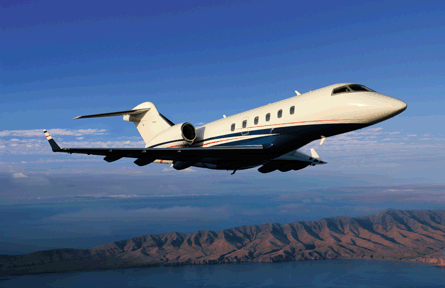 |
|---|
© Bombardier Flexjet |
The concept took nearly a decade to take off - due partly to many airframers' reluctance to sell aircraft to Santulli - but this niche market has revolutionised business aviation, spawning a mainly US-based industry dominated by "the top four": NetJets, Flexjet, Flight Options and CitationShares.
"You cannot underestimate the vital role that fractional ownership has played in the industry over the last 20 years," says aerospace analyst Rolland Vincent. Not only has it been a driving force behind high-cycle aircraft designs such as the superlight Cessna Citation Sovereign and super-midsize Bombardier Challenger 300, but it has single-handedly propelled customer service levels across the industry to new heights, he says.
"Also, by lowering the price point for entry into business aviation, scores of new customers have been able to enjoy the benefits of private aviation for the first time," Vincent adds.
These heady boom years have evaporated - at least for the foreseeable future - and the industry is experiencing major upheaval.
Santulli's recent dramatic exit from the company he founded, coupled with the high-profile collapse of Lisbon-based start-up Jet Republic, has sent shock waves through the fractional providers, which in recent months have been laying off workers and implementing cost saving measures to weather the economic storm and stem the heavy financial losses.
NetJets, for example, posted losses of $349 million in the first half of this year - revenue from flight operations was down by 22% and share sales by 81% - and is expected to record abysmal third quarter earnings.
However, NetJets' poor performance is merely a reflection of the depressed conditions that fractionals - and the rest of the business aviation market - have been forced to trade under over the past 10 months.
According to the UBS Investment Research's latest analysis of the fractional ownership market, the fractional fleet shrunk by 3% up to the end of August - after growing every 12 months for the past 17 years. Share sales are down by around 50% and overall business jet flight activity fell 25% compared to the recent peak in 2007, says report author and aerospace analyst David Strauss. He says only 66% of the US fractional jet fleet was sold at the end of August - excluding card programmes - compared with 71% a year ago and the 73% historical average for the industry.
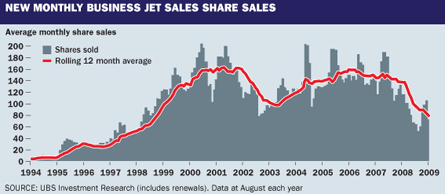 |
|---|
"The events of the past year have taken everyone by surprise," says Fred Reid, president of the second-largest fractional programme, Bombardier Flexjet. For the airframer-owned company - which operates close to 90 business jets - the downturn itself was not unexpected, but the speed and scale at which it took hold was alarming.
"We finished 2007 with a roar, but could see individuals pulling back even then," says Flexjet vice-president of sales Bob Knebel.
"By the fourth quarter of last year the owner exit rate across the industry rose dramatically above the typical 5-6% rate in any given year. Businesses were reviewing their total cost structures and deciding to adjust their ownership level [share size] because they didn't need to travel as much. We also saw for the first time that customers were blaming the lack of available finance for leaving and entering the fractional programmes."
DECLINE
This view is echoed by Woody Harford, senior vice-president of fellow manufacturer-owned fractional programme CitationAir, formerly CitationShares. "Our activity levels fell in line with the market and the folks who wanted to buy couldn't raise the finance, while others with the cash got nervous and chose not to buy. Subsequently we saw a significant decline, particularly between December 2008 and April 2009." Harford says the Cessna-owned programme - which operates the fourth-largest programme with fewer than 80 Citation types - was forced to cut its cost base and find ways to increase efficiencies - "operators who responded quickly have managed to rise it out. We are now operating significantly under budget," he says.
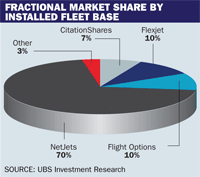 |
|---|
For Mike Silvestro, chief executive of the third-largest programme Flight Options, the slump in business aircraft travel across the industry has been a key component in the decline of fractional programmes. "Of course the finance squeeze has been a huge challenge for our industry," he says, "but business is also suffering from an oversupply of aircraft in a declining market and this has driven down the cost of business aircraft travel spectacularly," he says.
According to Strauss, the installed base of fractional shares has shrunk by 10% in the past year, but he says the fractional fleet has only fallen by 3%. "New monthly share sales [including renewals] were at 35 in August, roughly 56% lower from the previous year on an absolute basis and 38% lower on a rolling three-month basis. We estimate 574 new monthly share sales to the end of August - 40% lower than the same period in 2008."
Through the downturn the fractionals have turned to the tools at their disposal to retain and attract customers. Leasing programmes have become popular alternatives to outright acquisitions of fractional shares due to their "no financial risk" element. Similarly, card programmes in which customers buy block hours - typically around 25h - in a business jet or programme are hugely popular for nervous and cautious users. Although the hourly operating costs of these "risk-free" options is greater than for typical fractional programmes, their appeal has been instrumental in keeping many customers in the fractional fold.
"The card programmes and to a lesser extent the leasing offerings have been a lifeline to the fractional industry. Without them their decline would have been more rapid," says Vincent.
His view concurs with the UBS analysis, which singles out the role played by alternative programmes such as the card and leasing offerings in boosting the industry's sold-to-in-service ratio - which is used to measure the level of excess capacity in the fractional fleet.
"Although fractional providers typically build some degree of excess capacity into their fleets to ensure their ability to meet demand, we estimate the sold-to-in-service ratio [without card and leasing programmes] for the entire fractional fleet was 66% at the end of August, down significantly from 71% at the end of 2008 and the 73% average since 2003," Vincent says, adding that this was driven by a 50% drop in sales from peak levels.
He concludes: "Declining share sales combined with lower utilisation by existing shareowners has yielded fractional oversupply that we expect will result in the providers shrinking their fleets."
For many operators, this process has already begun. "We have reduced our fleet numbers to reflect the market conditions and are adding new aircraft to the fleet at a more modest pace," says Reid. "The key is not to be too big and too smart. We are focusing on profit and not market share."
CitationAir has slashed its fleet numbers from 85 in September 2007 to under 80 today and "has cut its order intake this year due to the soft market", says Harford.
Flight Options began to pare down its fleet five years ago - while under the ownership of Raytheon - cutting the number of used types in its inventory to four aircraft - the Hawker 400/800, Cessna Citation X and Embraer Legacy. The fleet has also been cut in the past year and the company now operates 85 aircraft, says UBS, and has a further 100 Phenom 300 light jets on order for delivery over the next 10 years. "We want to keep the fleet as young as possible and keep the types we operate to a minimum," Silvestro says.
Strauss says that "deliveries to fractional providers have dropped significantly, averaging three a month so far in 2009 and just one a month since April. This compares with 10 aircraft a month on average over the past 10 years or roughly 10-15% of total industry deliveries, he continues.
Vincent argues that fractionals must streamline their fleets if they are to operate efficiently. The existing business model is geared to rapid growth, he says. "So long as fleets expanded, providers could profit by buying new aircraft at discounts and selling them at list price to customers. But in the current environment the emphasis must be on making the operational side profitable or changing the business model altogether."
NetJets, for example, operates around 15 types in its US-based fleet of more than 460 aircraft "and although it might be appealing to customers to have a menu of aircraft of different shapes and sizes, this is a very expensive way of running a business," he says.
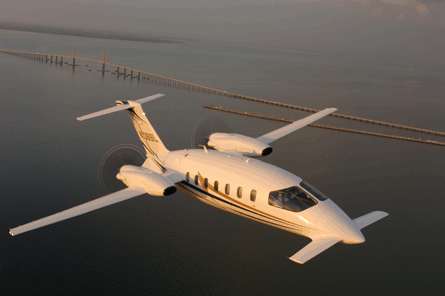 |
|---|
© Avantair |
It is unclear how NetJets plans to reverse the spiral of debt and regain its standing in the industry as the company has declined requests for interviews. It is evident, however, that restructuring is taking place under the stewardship of interim company chief executive David Sokol, who has already slashed 5% of the USbased workforce - equivalent to around 300 jobs - as part of a major restructuring effort at the beleaguered company. A cut in fleet numbers is inevitable.
Yet offloading unwanted aircraft in the current environment is problematic as the values of business jets have plummeted spectacularly over the past 12 months due - once again - to oversupply of aircraft and few buyers.
The dire state of the used aircraft market has also severely affected the resale value of fractional shares and has forced many customers to reluctantly extend their fractional contracts - in the hope that the market and subsequently secondhand aircraft pricing picks up - or exit the programme at a huge loss.
LOW PRICES
Providers have also been hit financially by the historically low prices and record numbers of customers departing from the programmes. "We have been winded by the number of asset writedowns," says Flexjet's Reid.
The solution to this problem for fractional providers is to put the onus on selling the aircraft share on to the customer rather than the provider, says Dan Dugger, founder and chief executive of online fractional share and whole aircraft trading company Fractrade. "The buyback option offered by many leading providers is crippling the industry and is causing bickering and in-fighting between the customer and programme operator," says the former NetJets executive. "I am trying to convince these providers to offer this option to their customers - it's simply an owner-to-owner transaction, an eBay for fractional shares, so to speak."
So far, Dugger has been unsuccessful. "Fractional providers are proprietary. They want to make a margin on the sale and don't want to relinquish control. The manufacturer-owned programmes need to manage how and when to release their aircraft types so they do not flood the used market and drive down prices, but that is already happening," he says.
However, Dugger argues that the residual values are hurting the industry. "It's very expensive to hold on to an aircraft that nobody wants, particularly, if the models in question have more than 6,000h on them - which a typical five-year-old fractional aircraft has."
Dugger says that some providers are also "playing dirty", by changing the rules to suit themselves, introducing hidden costs, hiking existing fees and not offering fair market values based on the industry bible - the Blue Book. "They are creating fear and anger in the market and leaving many customers with burnt fingers and sour tastes in their mouths," he says.
"Most of the programme providers are playing fairly, but they have lost a great deal of money. There is no question that the buyback guarantee has brought the industry to its knees. They have to stop painting over the cracks and create an open market solution," Dugger says.
This has been the approach of seven-year-old fractional provider Avantair since its conception in 2002. "We have devised a programme where the customer takes responsibility for the residual values," says Steve Santo, chief executive of the Clearwater, Florida-based Piaggio Avanti operator.
"The onus is on our customers to assign new owners to the aircraft, which they do through Fractrade," he adds.
Santo says many established programmes are not cost efficient. Like Vincent he believes they must "start behaving" like operating companies and stop focusing on making money through the acquisition and sale of aircraft shares or they will continue to lose money.
"We have seen record numbers of new customers since January and many of those have come from existing providers where have been badly burned by the low residual values of their aircraft," says Santo. He also puts the success of his programme down to the "versatile, understated and cost efficient" Avanti twin-turboprop. "We have lost between 1% and 2% of our customers - well below the industry average during this economic climate, but have grown 81% year on year," he says. Avantair beat its sales target for July and August by more than 80% and is planning to add 11 aircraft to its 53-strong fleet this year.
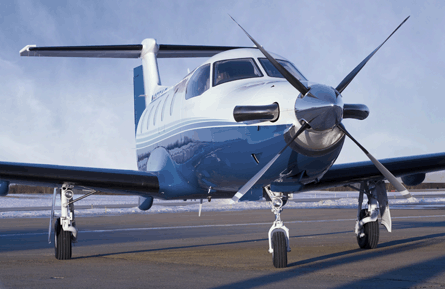 |
|---|
© Alpha Flying |
Fellow turboprop-based fractional provider Alpha Flying says it too has attracted customers to its Pilatus PC-12-based PlaneSense programme from the established jet fractionals as customers look for less expensive and low-key forms of business travel.
PlaneSense does not offer a guaranteed buyback scheme, "although of the small number of customers who left the programme we have managed to remarket the shares on their behalf," says AlphaFlying chief executive George Antoniadis. PlaneSense operates a fleet of 32 PC-12 single-engined turboprops in its north-east USA-based programme, where it is continuing to invest heavily in the quality of service.
"These are tough operating conditions, but given the backdrop we are continuing to sell shares. We expect to take delivery of two more aircraft before the end of the year and I'm in no doubt that the fractional model is here to stay as long it offers a value proposition to the customers," says Antoniadis.
Vincent echoes this view. Given the unsettled state of the business aviation industry, he says consumers will increasingly look to ownership-based programmes that keep the aircraft "away from public scrutiny such as leasing, jet cards, charter and fractional ownership".
Providers will continue to adapt their programmes and evolve their products by offering more options and flexibility, he continues and what will emerge in he near term is a leaner, more efficient fractional ownership industry focused on operating profits.
Flexjet's Reid agrees. "This has taught us to be smart, listen to our customers and react accordingly. We have introduced a number of measures such as flat price contract extensions to help them to continue flying through the crisis without having to face an immediate asset slump and we will continue to evolve."
Source: Flight International
















